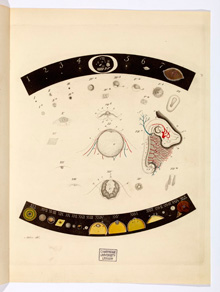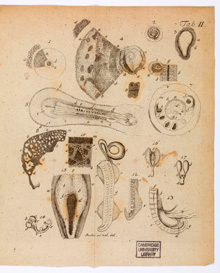From Generation to Reproduction

An investigation into generation, probably showing the surgical removal and microscopical analysis of ‘seminal fluid’ from a bitch, a discovery claimed by Georges-Louis Leclerc de Buffon, principal author of the influential multi-volume Histoire Naturelle. MG.7.2 (volume 2, 1750)
In the 1700s generation became a fashionable topic for conversation in enlightened salons and featured in books of philosophy, medicine, poetry and imaginary travels. Natural philosophers sought laws behind the multiplication of living individuals and populations. They reconceptualized generation as reproduction, which would come to involve biological processes of heredity and development. New specialities, from embryology to obstetrics, described women’s bodies as organized for reproduction. Ambitious doctors tried to improve the health of nations by combating abortion and infanticide and taking over the supervision of childbirth from midwives. The discovery of the mammalian egg, definitively described in an 1827 treatise, suggested the power of scientific inquiries. By the mid-nineteenth century there were new roles for specialist investigators, a new stress on publication in journals, and new places of work in museums, laboratories and surveys.

In focusing on the birth of its central protagonist, Laurence Sterne’s The Life and Opinions of Tristram Shandy, Gentleman… (1759) mocks not only traditional memoirs and novels, but also the ambitions of contemporary theories of generation. CCD.5.81–84

Copper engravings from Karl Ernst von Baer De ovi mammalium…(1827), showing the dog embryo up to about three weeks (VII), the human egg (XIII), and for comparison, those of other vertebrates and a crayfish. MB.52.1

One of the founding works of modern embryology, Caspar Wolff’s Theoria generationis (1774) proposes a ‘theory of generation’ for plants and animals. This plate shows chick embryos and their parts. CCD.46.87, table 2


